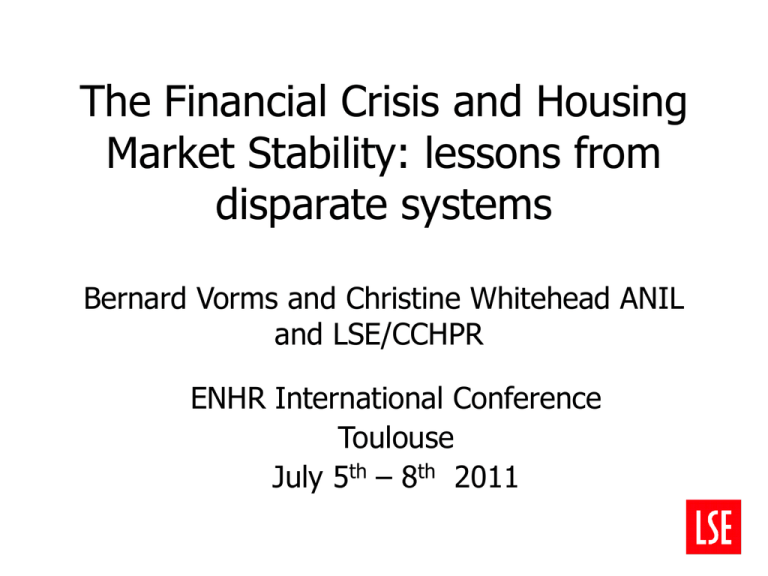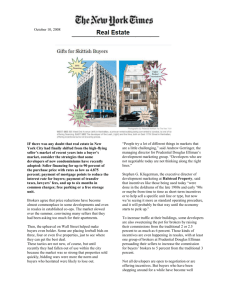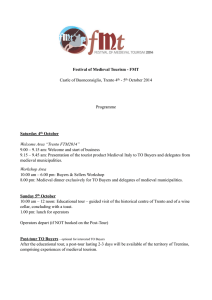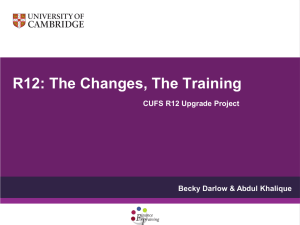ppt-click here - 23rd Enhr Conference 2011
advertisement

The Financial Crisis and Housing Market Stability: lessons from disparate systems Bernard Vorms and Christine Whitehead ANIL and LSE/CCHPR ENHR International Conference Toulouse July 5th – 8th 2011 The Impact of the Financial Crisis on Owneroccupation in the UK and France • The position in 2007 • Short run effects of the financial crisis in the UK and France • Financial effects and real effects • Longer term implications Pre-Crisis Events in the UK • Very rapid rises in house prices – out of line with fundamentals from 2005? • Growth in sub and near prime lending – but nothing like as apparently out of control as in the early 1990s • Growth in wholesale funding –in 2007 17% of gross advances but 75% of net advances • Northern Rock – a UK made crisis in September 2007 • Some decline in proportions of first time buyers from 2005 • Housing investment started to fall before the crisis in 2007 (peak in starts early 2006 though peak in completions 3rd quarter 2007) Immediate Effects on Housing and Mortgage Market • Near removal of sub prime market – 1.6% credit impaired 2008: 3; 0.35% 2009: 3 • Near removal of mortgage backed securities market - negative net advances 2009 and 2010 • Expectations of continuing house price rises reversed. House price down 9% 2007-2009 • Massive reductions in transactions (down 50% 2007-2009) and mortgage lending (down 60% 2007-2009; Buy to Let down 80%) • Output levels – starts down 70% from 2006:1 to 2009:1; completions down 50% from 2007:4 to 2010:1 BUT • Interest rates also down (base rate 5.75% to 2009: March 0.5%) – helping existing mortgagors but not first time buyers Second Round Effects: Consumers • More general recession – lower levels of activity; increased unemployment; but mainly short time/wage reductions • Impact on existing owner-occupiers much less than expected – lower interest rates allowed repayments to remain affordable; refinancing market worked relatively well – so were able to remortgage; no incentive to take homes into possession • Main concern in the existing owner-occupier market owners is the problems for second round movers – the UK system has worked by large volumes of transactions and people starting in small property and moving up but large proportion will have little more equity than for their first home – so can’t filter up the existing stock leaving housing available for first time buyers Impact on First-time Buyers • Major problems for first time buyers. Potential entrants require far higher deposits and face far more stringent terms and conditions; • Also uncertainty about future house prices and future jobs is reducing demand – so question as to the relative impact of demand and supply of funds • Currently thought to be one million ‘missing’ owneroccupiers • But an alternative available in the private rented sector helped by the Buy to Let expansion in the early 2000s • But rents now rising rapidly as transfer of demand from owner-occupation and new build below household formation rates Lending to FTBs (loans advanced) Typical FTB deposit illustration Second Round Effects: New Supply • Relatively small overhang of completed or near complete dwellings. But many, especially large regeneration, projects mothballed • Overhang of over optimistic land prices – rightdowns difficult to organise without major bankruptcies (bank ownership etc.) • Lack of funding for development – including lack of a presale rental market • Lack of an equity base to support new activity • Significant reductions in new investment Declines in housing investment Quarterly housing starts and completions Started: pri vate Started:Al l Compl eted: Pri vate Compl eted: Al l 2 0 Q4 10 Q 1 3 Q 2 Q 2 0 Q4 09 Q 1 3 Q 2 Q 2 0 Q4 08 Q 1 3 Q 2 Q 3 Q 2 Q 2 0 Q4 07 Q 1 20 06 Q 1 60,000 50,000 40,000 30,000 20,000 10,000 0 Availability of funding – demand or supply? • • • • • Gross advances down to 37% of 2007 levels Net advances down to 8% of 2007 levels Wholesale funding only 5% of gross lending Interest rates down 40% to an average of 3.6% Numbers of loans roughly halved – percentage of first time buyer roughly constant • Percentage advance for first time buyers down from 90% average in 2007 to 79% at beginning of 2011 Government involvement • Large scale supply subsidies brought forward for 2009 and 2010 - but now massive reductions in supply subsidies • Some small schemes to help mortgagors in difficulties • Homebuy Direct and now First Buy – help for developers and first time buyers through shared equity schemes partially funded by government • Increased regulation in the mortgage market but pressure to expand first time buyer loans Longer term trends in owneroccupation in England • Owner-occupation reached its peak in 2003, at almost 71%. Because of cohort effects it was predicted to go to around 73% and government was looking for 75% plus • Yet the proportion of those buying with a mortgage was higher in 1991, suggesting some slowdown in entry. Since 2006 this downward trend has strengthened • Age related ownership rates have showed declines among younger households since the crisis in the early 1990s Figure 1: Home ownership rates by age, England: 1984-2008 (%) 80 60 40 20 0 1984 <25 years 1989 1994 25-29 years 1999 2004 30-34 years 2008 All households Long term or short term? • Current owner-occupation level is exactly the EU average • Signs that affordability problems are keeping younger households out of owner-occupation • Availability of credit benefits existing owneroccupiers more than first time buyers – enabling existing owners to increase consumption and/or become landlords for their children • Those who do enter at younger ages tend to be helped by their family • But is renting a better option for these groups? Figure 5: Home ownership rates and 2 and 10 year aspirations Home ownership, 2 and 10 year preferences 85 80 75 70 65 60 55 1983 1986 1989 1992 1995 Actual 1998 2 year 2001 2004 10 year Source: YouGov (2010), MORI (1996-99), BMRB other; CLG. 2007 2010 Into the Future: UK • New build rates at best static and industry capital base massively adversely affected • Number of households still projected to rise; • FSA Housing Market Review could exclude large numbers of potential purchasers from obtaining funding • Wholesale market still very difficult and alternative uses of funds more profitable • Owner-occupation rates likely to continue to fall Conclusions • The medium term crisis relates to funding availability and regulatory change – cannot significantly expand lending to either rental or ownership in current environment • Potential for equity based partial ownership approaches to reduce costs still appears limited (shared equity; institutional investment in housing) • Supply side cannot readily improve without funding for demand and developers • So potential for volatility and intergenerational inequities increasing • But longer term case for owner-occupation rates not far below those of mid 2000s quite strong because of fundamental benefits of control, lifetime expenditure patterns and savings to government.










